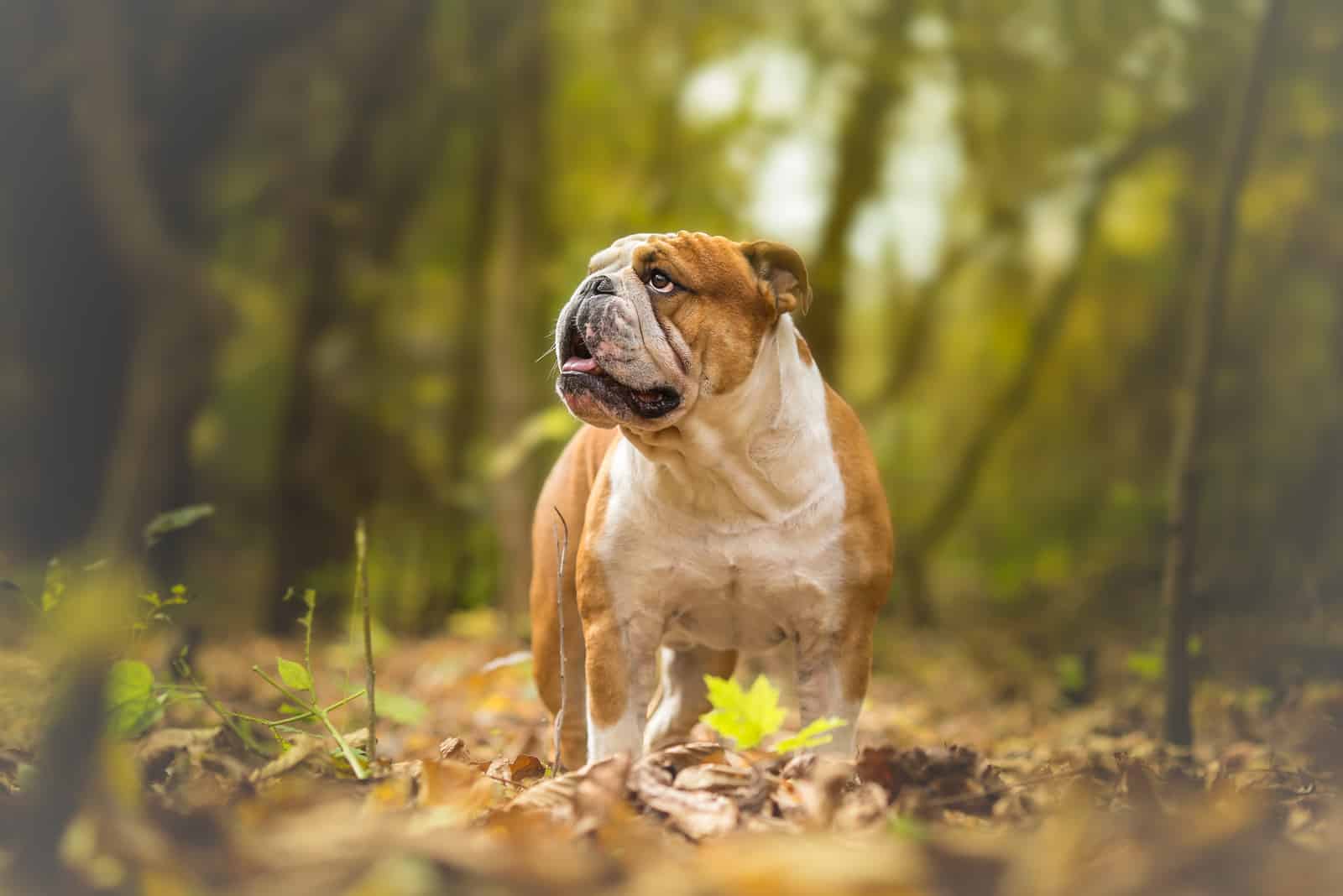When people hear the name Bulldogs, they think about these vicious dogs with a terrible reputation that everyone is afraid of. English Bulldogs, however, are anything but that.
The English Bulldog is one of the sweetest dogs out there. They are predictable and dependable, making them some of the most amazing family pets. They love their owners with all their hearts, and they’ll do anything they can to gain human attention.
At the same time, they are brave dogs, which shouldn’t be a surprise considering these pups were bred for bull baiting – hence the name Bulldog. This means they can make amazing watchdogs, something not expected from their small stature.
Their personality, combined with their adorable, wrinkly faces, make them adored by dog owners worldwide.
However, how much do you know about English Bulldog colors? Did you know that these dogs can come in some exotic patterns, making them truly stand out from the crowd?
Yes, there are more surprises to this breed than you might think!
If you want to know what some of the English Bulldog colors are, this article is for you!
English Bulldog Colors Chart
[table id=147 /]
Breed Overview
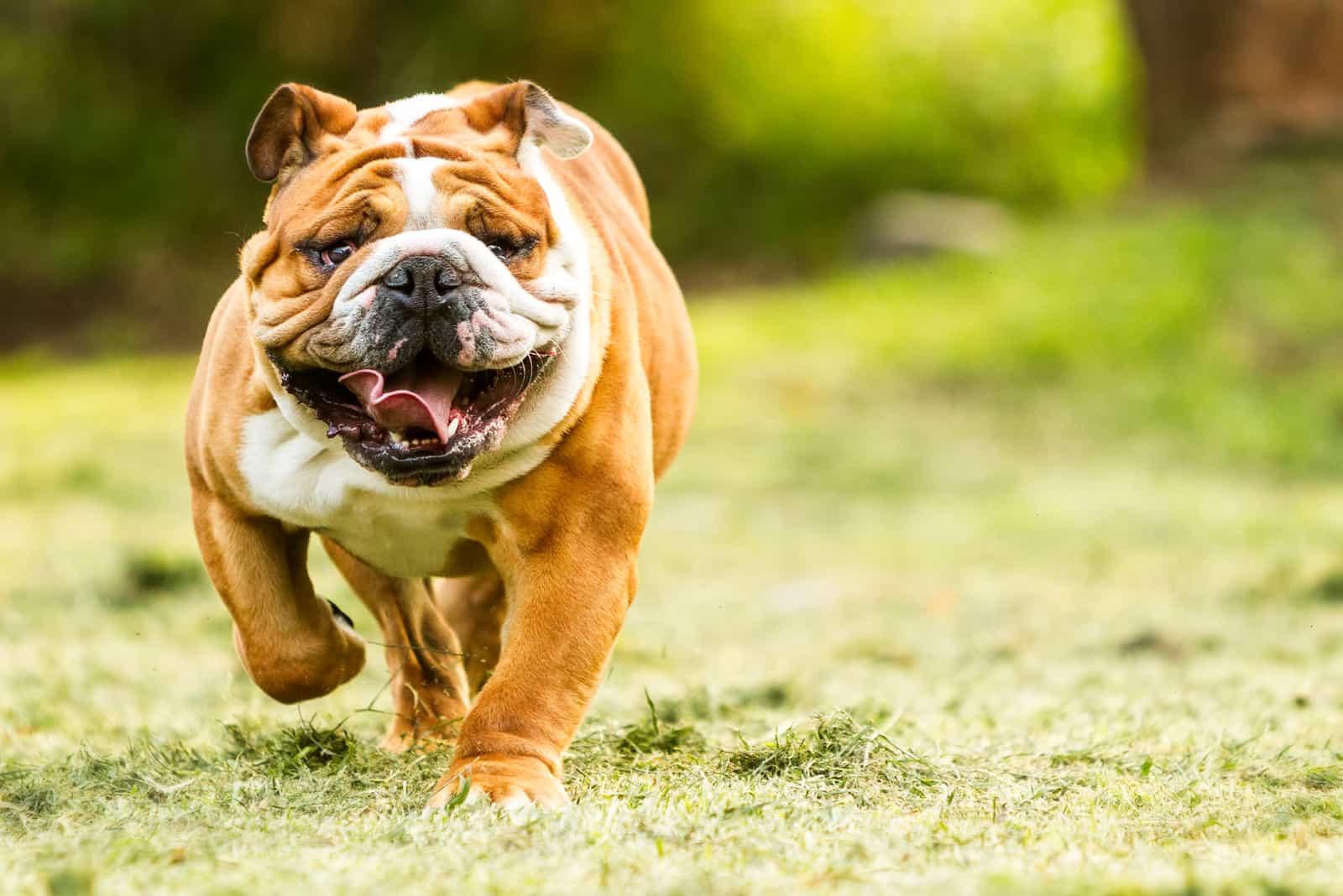
English Bulldogs don’t look too much like the Bulldogs you might think of when you hear the breed’s name. This is because they aren’t closely related to Pitbull breeds. In fact, this breed was first mentioned back in 1209 in an article about a butcher’s dog that chased a bull all the way through the English town of Stamford.
These pups have a flattened appearance because of their short muzzle and wide, low-set eyes. Their skin is wrinkled, and this is one of the features people love the most.
They have a broad, muscular body with a deep chest and stocky legs, and they are rarely over 16 inches tall – but this doesn’t stop them from weighing around 54 lbs, which can be quite a lot for a dog of this size.
As mentioned before, these dogs were bred for bull baiting, and their strong body reminds us that these are hard-working dogs.
At the same time, however, they are extremely devoted to their owners, and they can be lazier than one expects, making them a unique mix of a calm personality and muscles.
English Bulldog Coat And Care
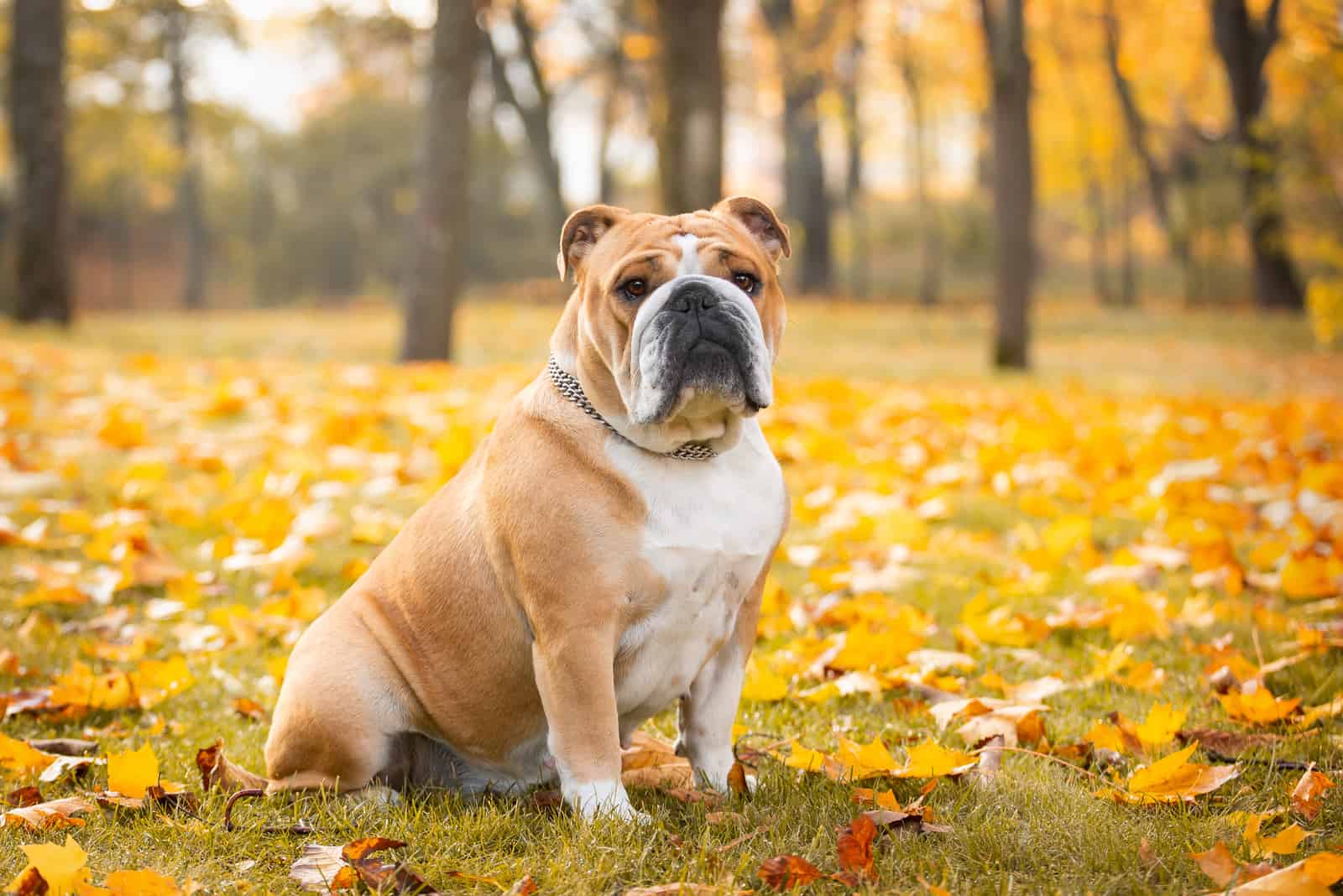
The English Bulldog breed has a soft, short coat that doesn’t shed too much, but this might still be noticeable during the shedding season, which usually occurs around early spring.
Fortunately, their short hairs aren’t that visible on furniture or clothes, and they aren’t a huge pain to clean. Still, they aren’t hypoallergenic, especially because they tend to drool a lot.
While you don’t have to cut their coat, you should still brush them a few times a week. Luckily, these mellow dogs will love their grooming sessions, making you enjoy some mutual bonding time.
Keep in mind that you should take good care of their wrinkly skin as well. Otherwise, they might experience some health issues, such as infections, which can lead to hair loss if left untreated.
You don’t have to bathe your English Bulldog too much, but they can be quite sloppy and tend to love getting in the dirt. This might make you have to wash them more often than you’d like.
These dogs can have sensitive stomachs, and any changes in their diets can make them lose patches of hair. If you notice that your English Bulldog has bald spots, try to remember whether you’ve changed the dog food you give them.
As these pups are prone to obesity, make sure you take good care of the food you give them. Don’t feed them human food, especially if it’s spicy – and don’t give in to the puppy face they’ll give you! These dogs will do all they can to grab a bite of everything you eat.
If you feel like you have to give them treats, opt for a healthier alternative, such as tuna, brussels sprouts, or even durian.
Something that their distant relatives, French Bulldogs, are known for isn’t common knowledge about these pups, and that’s that the English Bulldog’s short coat comes in various colors. Yes, you can find them in almost all coat colors available in dogs!
We’ll explain a bit deeper.
English Bulldog Color Genetics
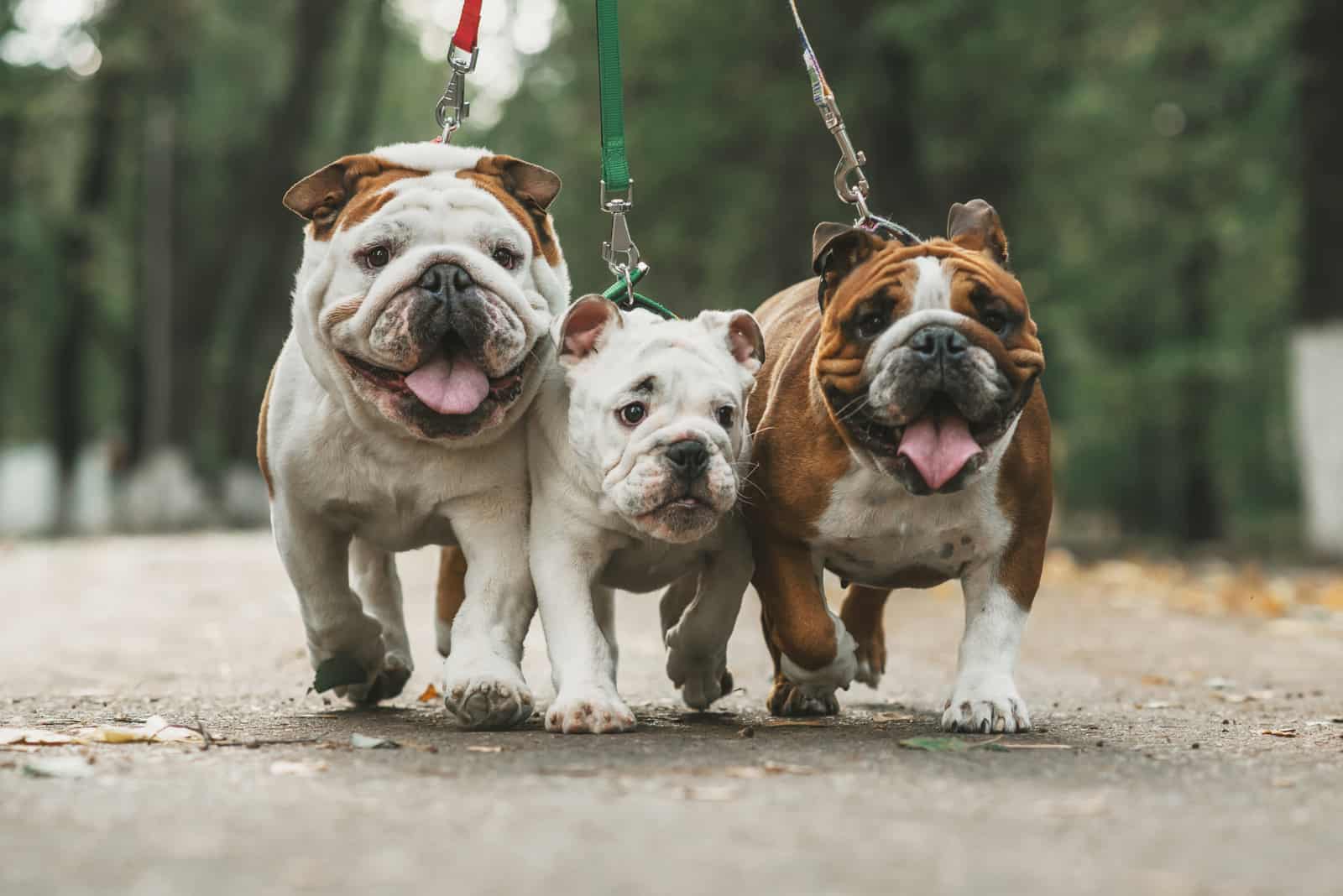
English Bulldog colors are determined by their genetics. We’ll simplify.
Each English Bulldog – just like all other dog breeds – will inherit one color allele (a pair of genes) from both of its parents. These two alleles go in one locus (location), and these make up a dog’s color genotype. Genotype determines a dog’s phenotype.
In other words, a genotype is what’s on the inside, while phenotype is what’s on the outside.
For example, if you have a blue English bulldog, the loci are called ‘D.’ The possible alleles inside this loci are ‘d’ and ‘D,’ and each dog can be either ‘dd,’ ‘DD,’ or ‘Dd.’ These are the genotypes.
Next, a ‘DD’ genotype will produce a dog that is most likely black. This is a phenotype. Similar to that, a ‘dd’ genotype will produce a blue dog. This is how the genotype determines a phenotype.
The same goes for any of the English Bulldog colors. There are two alleles that make a gene that will, in turn, result in the specific appearance of a puppy.
Genes determine the overall coat appearance and not just the English Bulldog colors. Thanks to specific alleles and genes, a dog might come in sable, brindle, tuxedo, or even merle!
Also, there are recessive and dominant genes. In dominant genes, only one allele is enough for the specific color or pattern to express itself. On the other hand, a dog needs to inherit two recessive genes to be a specific color.
English Bulldog Standard Colors
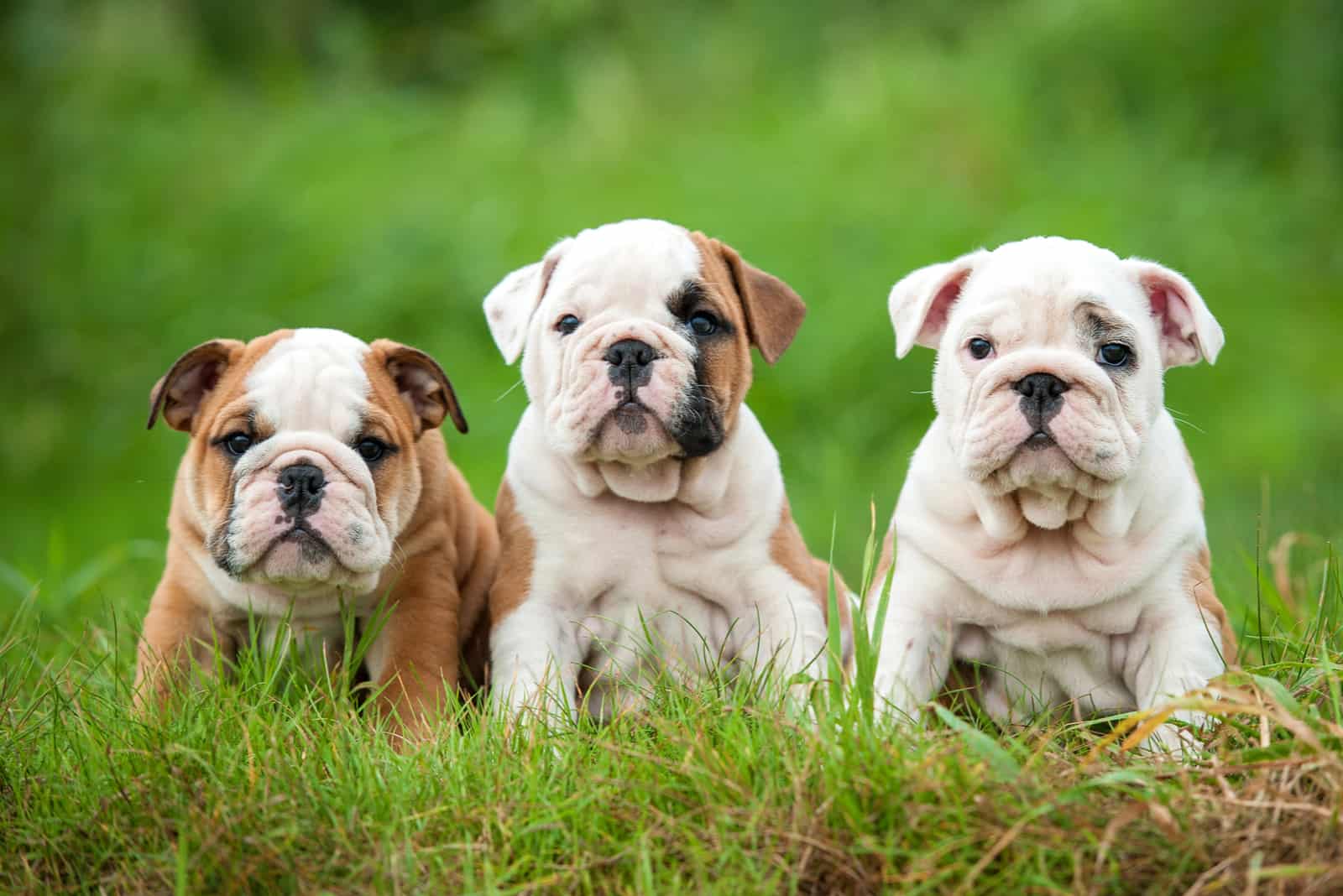
While there are many English Bulldog colors, not all are recognized by the kennel clubs. For example, the American Kennel Club (AKC) recognizes only four main standard colors.
This doesn’t mean that dogs that come in other colors are necessarily considered faulty. However, you won’t be able to register a dog that isn’t of a standard color, and you won’t be able to apply for it to participate in dog shows.
Some colors aren’t considered standard because they are connected to certain health issues. Others were introduced to the English Bulldog breed genetic pool by crossbreeding them with some other dog breed, such as the French Bulldog.
What makes all of this a bit more complicated is that not all kennel clubs have the same breed standard when it comes to English Bulldog colors. Some colors and patterns are accepted by the FCI or UKC but not by the AKC and vice versa.
Keep in mind that these colors don’t apply for any of English Bulldog crossbreeds, such as the English Bulldog Pug mix. All mixed breeds have their own set of colors they can come in.
AKC English Bulldog Colors
As mentioned before, there are four standard English Bulldog colors according to the AKC. These colors are:
• White
• Red
• Fawn/fallow
• Brindle
• A mix of two of these colors
Of course, these are just solid colors; English Bulldogs come in a variety of patterns, so you can, for example, find a red and white English Bulldog, a white and brindle one, and so on.
White English Bulldog Colors
White is one of the more common English Bulldog colors, but there is a catch. Pure white Bulldogs, also known as platinum, shouldn’t have a single hair of any other color – but this is a rare sight.
This is why they are allowed to have up to 10% of their coats covered in some other color.
Instead, most white Bulldogs come in at least two colors, so you may find a doggy with a white coat but a black mask, a white Bulldog with tan points, a white and fawn Bulldog, and so on.
Some common white English Bulldog colors are:
• Solid white
• White tri-color
• White and tan
• White and fawn
• White parti
Red English Bulldog Colors
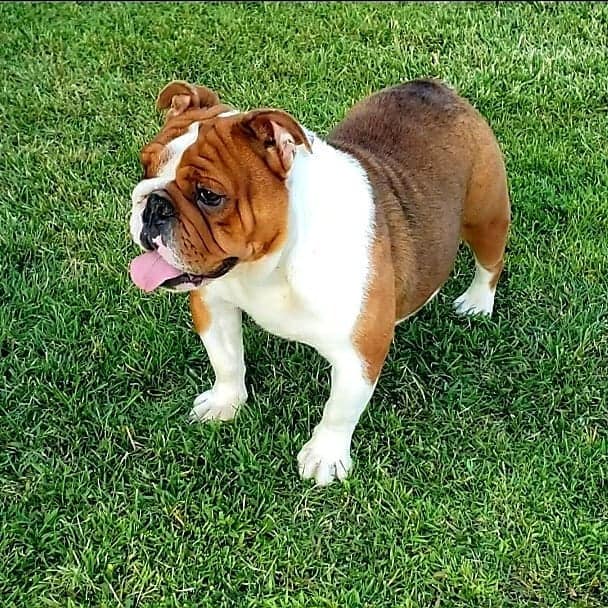
Photo from: @kjsbulldogs
Red is a pretty standard English Bulldog color. These dogs can come in any shade of red, from light ginger to deep red that might look similar to chocolate.
It’s important to note that all red English Bulldogs have black noses, eye rims, paw pads, and lips. This makes them different from chocolate English Bulldogs that have a brown nose and so on.
Some of the common red English Bulldog colors, both recognized and unofficial, include:
• Red and white
• Solid red
• Red and fawn
• Red merle
• Red brindle
Fallow English Bulldog Colors
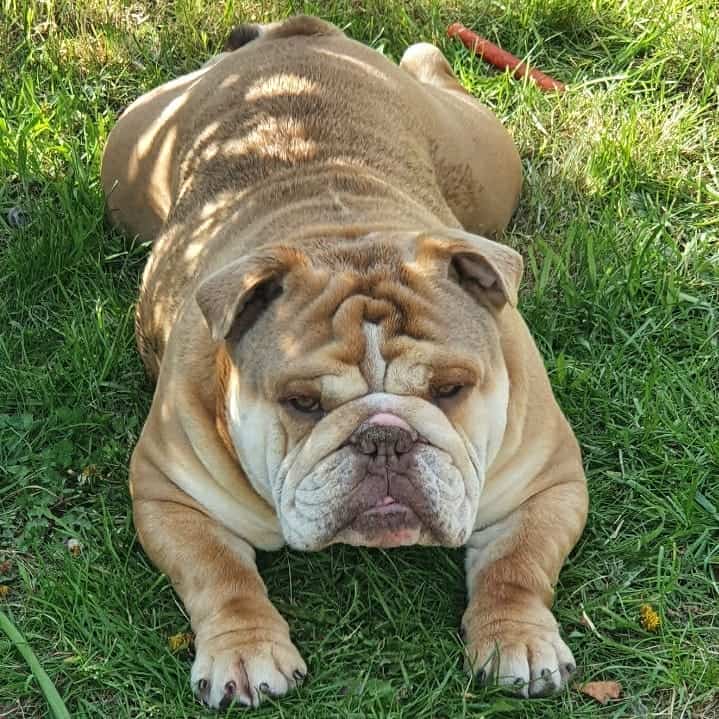
Photo from: @north_west_bullz
While fawn is a color commonly connected with furniture or clothing, it is also a popular color for many dog breeds – including English Bulldogs. The exact shade can be described as a light tannish yellow color, but it can be lighter or darker. Sometimes, it can even be as dark as a deep red color.
The first recorded time the name fawn was used was in 1789 in England, and this is the exact country these cute Bulldogs are from, which is a fun coincidence, especially considering that it’s a popular color for these pups.
In recent years, fallow is a word most people use to describe this color, especially in English Bulldogs.
Brindle English Bulldog Colors
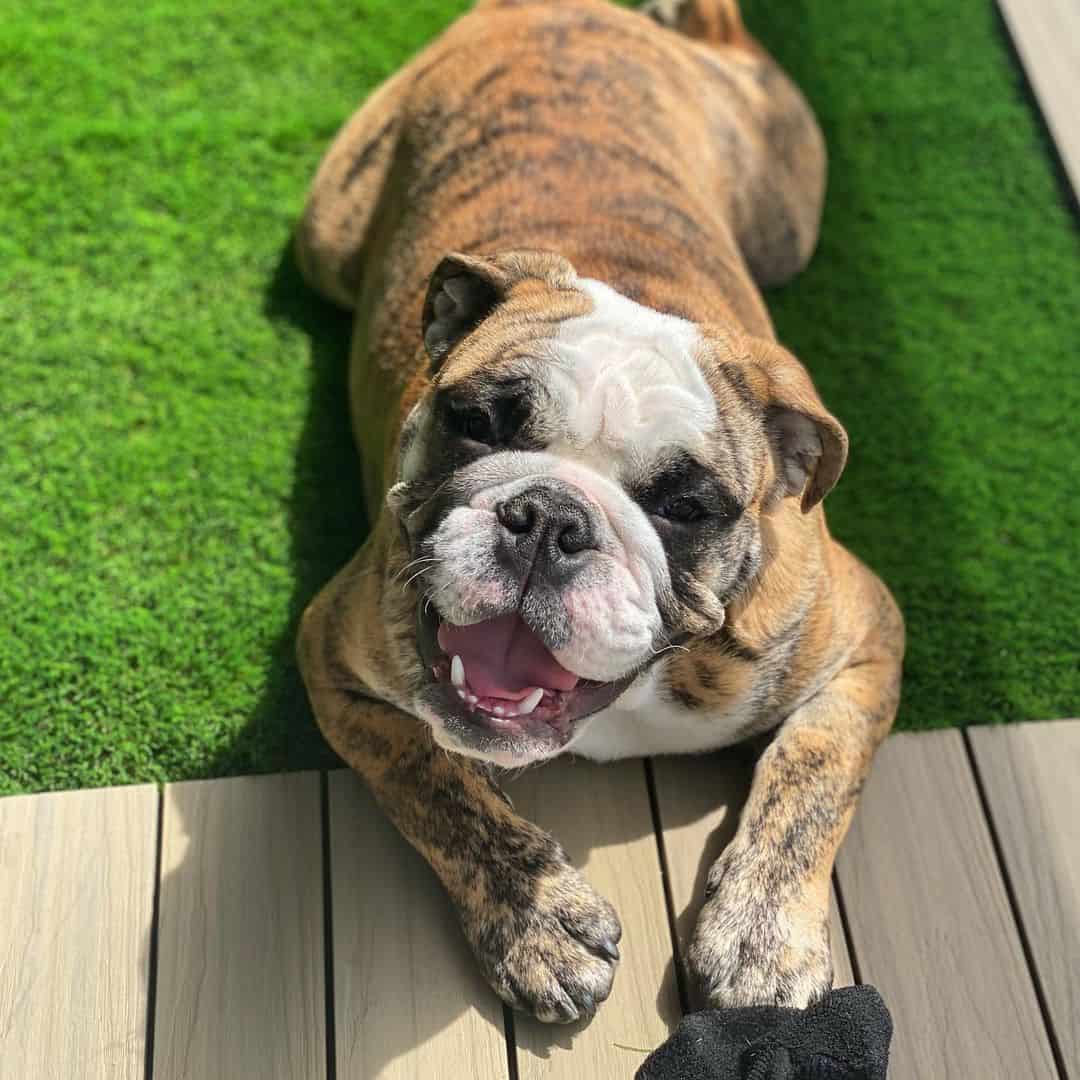
Photo from: @bodethebully
While some other English Bulldog colors might be more recognizable, brindle is the signature English Bulldog breed color.
A brindle pattern in dogs, essentially, means striped dogs. This pattern is characterized by dark, tiger-like stripes that can cover an entire dog’s body or just a portion of it. The brindle stripes give the dog a unique appearance, making it look rare and regal.
The brindle pattern can occur on any base color, so you can have a chocolate brindle English Bulldog, a white and fawn brindle English Bulldog, a red brindle Bulldog, and so on.
Non-Standard English Bulldog Colors
While there are four standard English Bulldog colors, there are many more non-standard ones. These colors include but are not limited to:
• Black
• Blue
• Lilac
• Chocolate
• Seal
• Trindle
• Merle
• Albino
Just like with standard English Bulldog colors, most of these shades can be combined with one another. This means you can find a white, black, and chocolate tri-color English Bulldog, a blue merle, or a lilac seal one.
It’s important to repeat that there is a good reason why many of these colors are frowned upon. Most notably, some of the shades have been connected with increased chances of developing certain health problems.
Black English Bulldog Colors
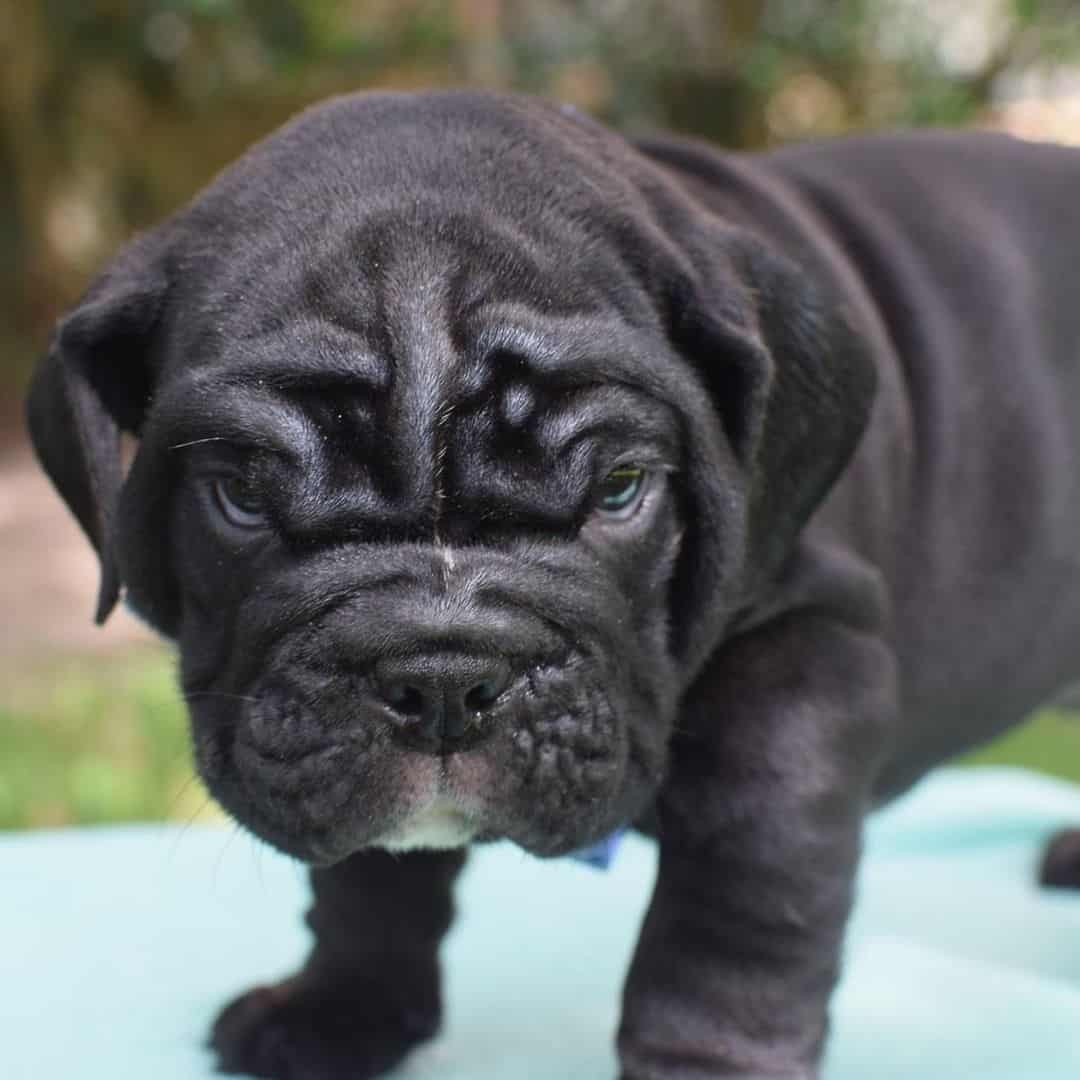
Photo from: @houstonenglishbulldogs
Solid black English Bulldogs are very rare, but they do exist. This color should appear black no matter the lighting – otherwise, it will be considered dark blue, dark chocolate, or even seal.
Most black Bulldogs come with some pattern, including white markings, tan points, pied, or black tri-color. Still, the most dominant shade should be the black color.
Some black English Bulldogs have a fawn undercoat that remains unnoticed until you rub the coat backward.
All black English Bulldogs must have black noses, eye rims (or eyeliner), lips, and paw pads. Otherwise, they cannot be considered black.
Black English Bulldog colors include:
• Black tri-color
• Black seal
• Black and white
• Black platinum
• Black merle
Blue English Bulldog Colors
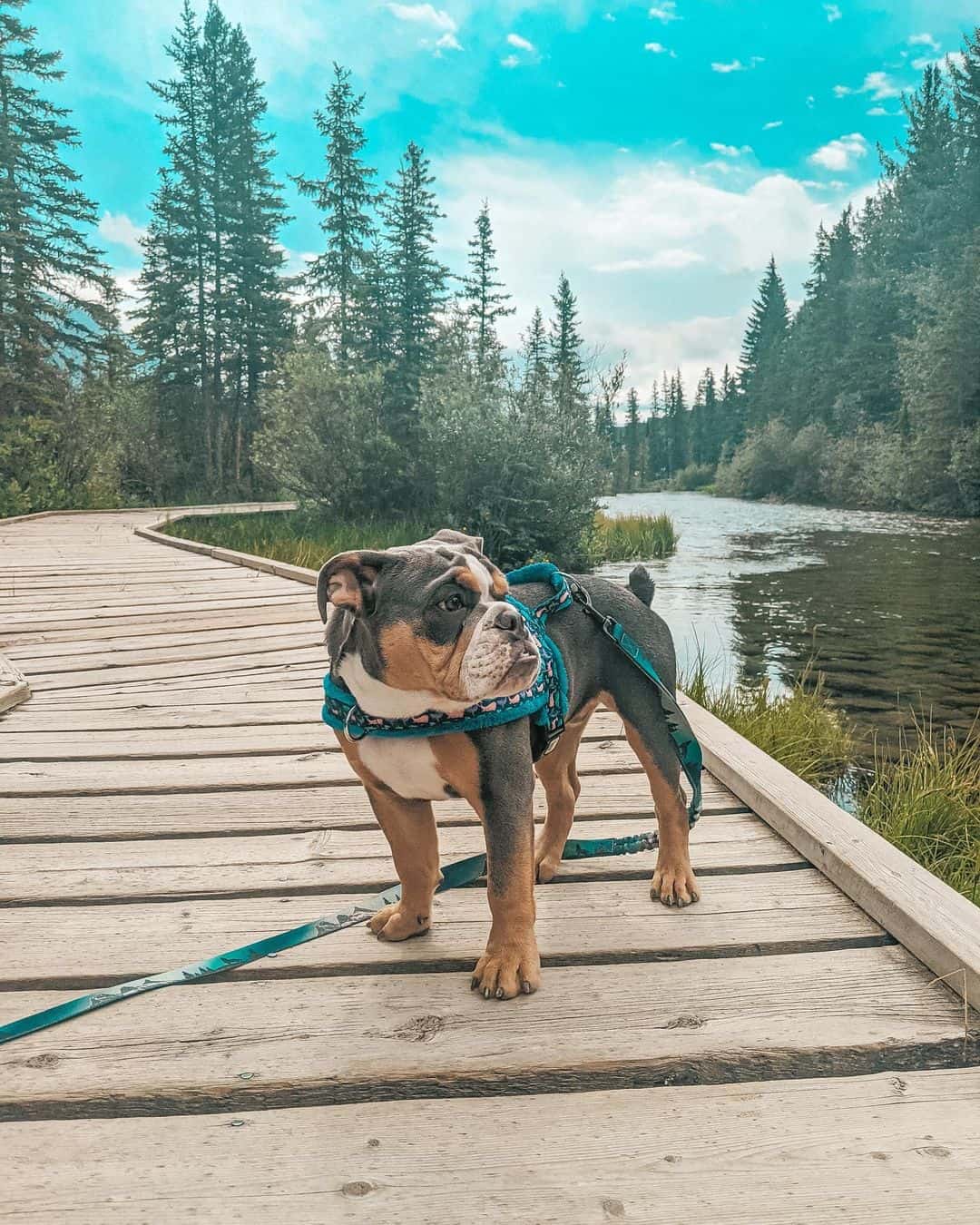
Photo from: @boomtownthebulldog
Blue is another fairly rare English Bulldog color. This is actually a black dog with a dilution gene that turns the black color into blue.
The blue coat color is, in fact, a specific shade of grey that appears to have a bluish tint under certain light. Just like black Bulldogs, they might come with a fawn undercoat.
All blue English Bulldogs have slate grey noses, eye rims, lips, and paw pads. Some might even have blue eyes, making them very rare and expensive.
While blue can come in all patterns – including blue brindle, blue tri-color, or a blue and white English Bulldog – one color remains unique: the blue fawn.
In blue fawn English Bulldogs, the coat color itself isn’t diluted, and it stays in a perfect fawn shade. However, the dog’s skin – including the eye rims, nose, paw pads, and lips that we’ve mentioned above – remains blue, while in standard fawn Bulldogs, these skin areas are always black.
Some of the common blue English Bulldog colors are:
• Blue and tan
• Blue tri-color
• Blue and white
• Blue brindle
• Blue merle
• Blue platinum
• Blue fawn
Chocolate English Bulldog Colors
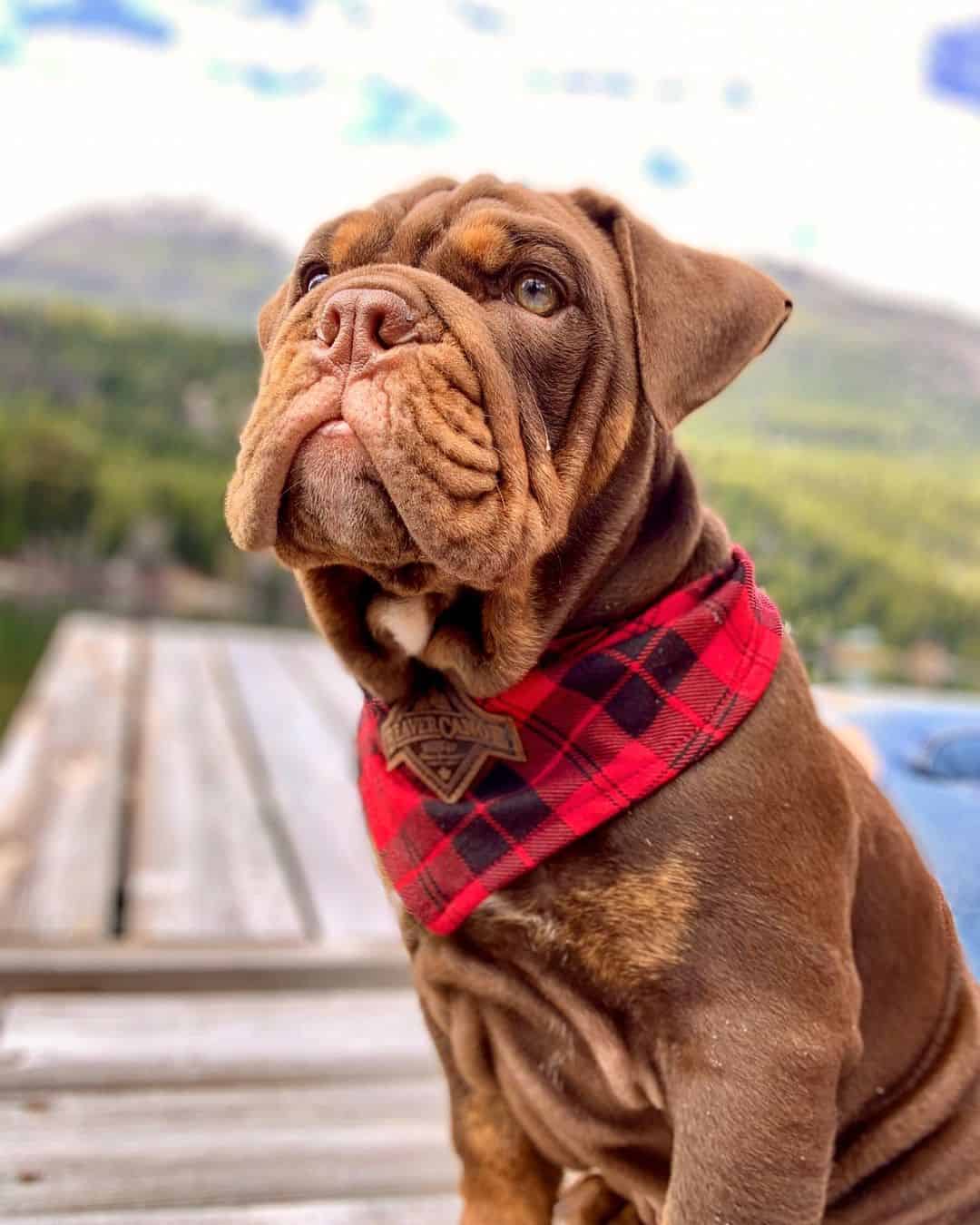
Photo from: @grumpy_gus_the_english_bulldog
Just like blue English Bulldogs, chocolate Bulldogs are simply a black Bulldog with a dilution gene. However, this specific gene dilutes the black color, not into blue but brown.
As this English Bulldog color comes from black Bulldogs, these pups may come with a fawn undercoat that isn’t affected by the dilution gene.
If you are uncertain whether a dog is chocolate or some other shade, look at its nose. In chocolate Bulldogs, the nose, lips, eye rims, and paw pads are always brown, no matter the hair shade.
While there are many patterns in chocolate Bulldogs, the most notable is a chocolate fawn Bulldog. Just like in blue fawn dogs, the fawn color isn’t diluted, but if you look at the pup’s nose, you can see that it’s brown in color.
Another rare brown pattern is chocolate platinum, which includes all white dogs with a minimal body color that is most likely distributed as spots on the pup’s face and tail.
While not as common as with blue English Bulldogs, chocolate Bulldogs can also have blue eyes, but this is extremely rare.
Keep in mind that a chocolate Bulldog shouldn’t have any black pigment on its fur or body.
Chocolate English Bulldog colors you can commonly see are:
• Chocolate and tan
• Chocolate trindle
• Chocolate seal
• Chocolate brindle
• Chocolate merle
• Chocolate platinum fawn
Lilac English Bulldog Colors
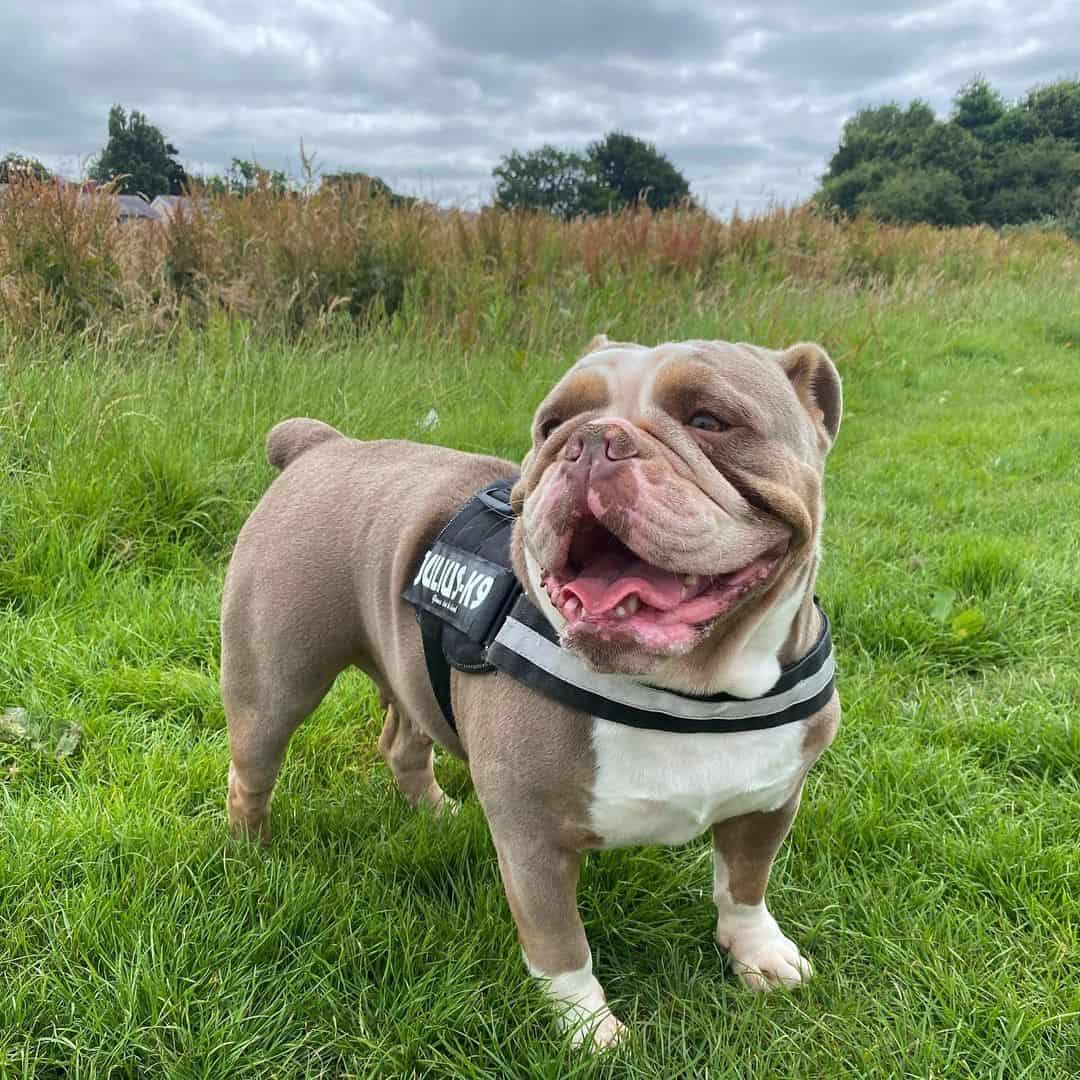
Photo from: @jjenglishbullz
Lilac is a black English Bulldog that has gone through dilution of its pigment not once but twice.
This color happens when a black dog has both the gene for blue dilution and brown dilution. Once these two are mixed, the dog is diluted to a unique purple color.
Lilac Bulldogs appear in a Weimaraner grey shade or some other shade of lilac. Once again, as they do originate from black Bulldogs, a fawn undercoat is common.
The nose of lilac Bulldogs isn’t blue, brown, or black, but rather pink or some other purple color.
There is a lilac fawn Bulldog, and just like with blue or chocolate dogs, this dilution doesn’t affect the coat color but only the skin.
Lilac English Bulldogs are rarely solid-colored. Instead, you can have a lilac tri-color, a lilac pied, or even a lilac brindle!
Common lilac English Bulldog colors are:
• Lilac tri-color
• Lilac and tan
• Lilac merle
• Lilac seal
• Lilac brindle
• Lilac platinum
• Lilac fawn
Seal English Bulldog Colors
There still isn’t enough evidence to suggest which gene causes the seal color in dogs, including English Bulldogs.
Seal is a rather unique coat color. It means that there is an undertone color underneath the pup’s true color. Usually, this undertone is in a reddish or brownish shade, but any other shine is possible.
When it comes to this specific color, you may find English Bulldogs in these shades:
• Black seal
• Blue seal
• Chocolate seal
• Lilac seal
This seal ‘effect’ might make the true color appear muddy, but the coat will still be shiny and glossy, making it one of the most beautiful English Bulldog colors out there.
Trindle English Bulldog Colors
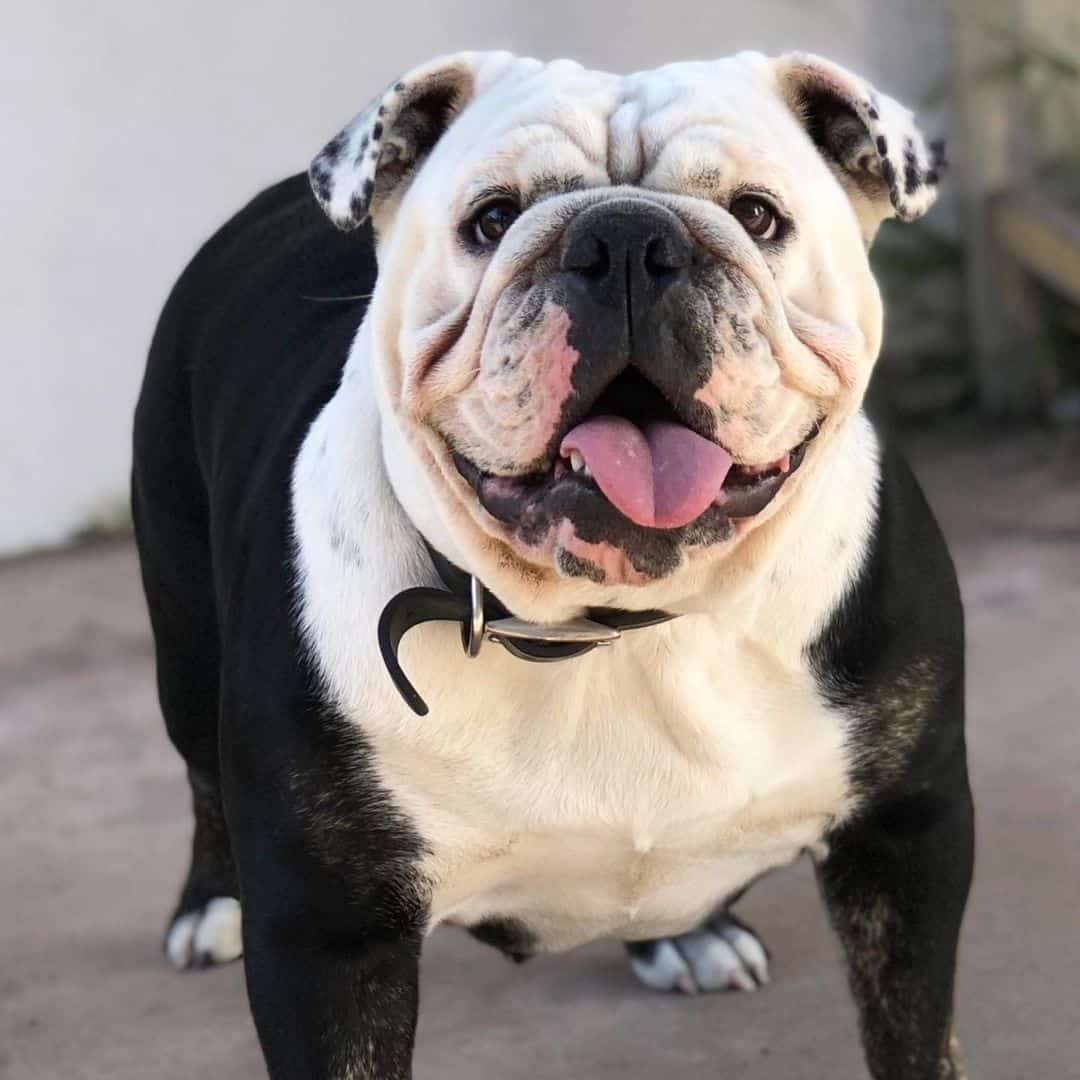
Photo from: @harleyq_thebulldog
Trindle is a very specific coat color in dogs that is somewhat rare. Plainly speaking, a trindle is a dog with a full brindle, but this pattern only shows up on tan points.
If you’re unsure what the tan color is, this is that brownish/tawny color you can see in an English Bulldog’s fur.
Trindle English Bulldogs are almost always tri-color, which is what makes them different from regular tan brindle dogs.
Merle English Bulldog Colors
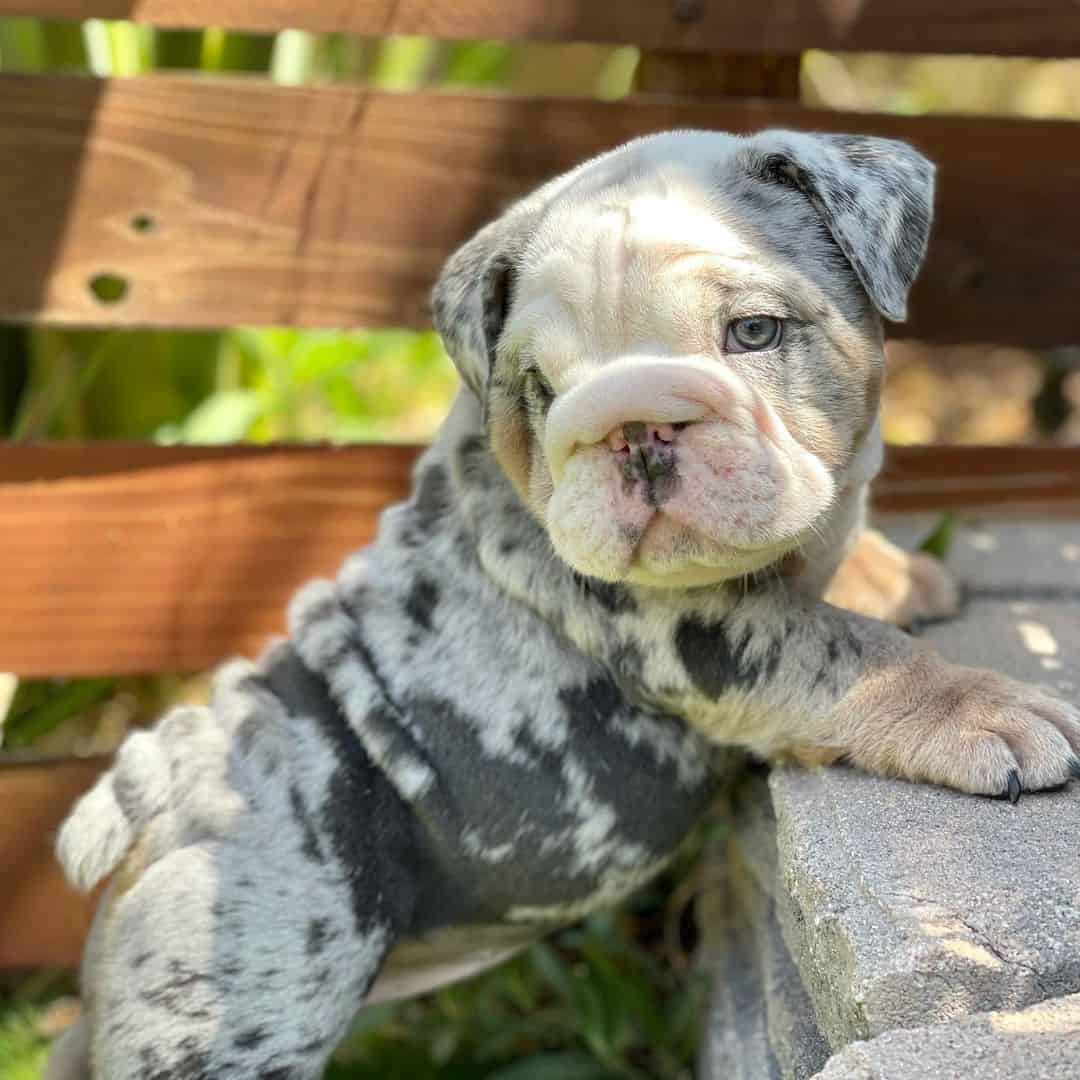
Photo from: @mauloabulldogs
Merle is one of the most frowned-upon English Bulldog colors.
Merle is the result of the specific merle gene. If your dog inherits only one allele of this gene, it will dilute random portions of hair to a lighter color and pure white while also leaving patches of the original color.
These dogs might look like tri-color ones but with specks and spots of various shades of the same color. All patches might look jagged on the outer edges, and some of these dogs might look spotted or even parti.
This dilution, however, doesn’t just affect the coat color of these pups. Instead, their skin will be affected as well. This means that the noses, lips, and paw pads of merle dogs will be in color patches too.
At the same time, the pigmentation in the eyes will also be diluted. You’ll often find merle dogs with blue eyes or just one blue eye (heterochromia). One of the dog’s eyes can even be in two colors!
However, the true problem comes with so-called double merles. These dogs have two alleles of the merle gene, so the dilution is complete. Because of this, they look pure white with blue eyes.
The problem with this lies in the fact that the merle gene dilutes every part of the dog’s body. This means that English Bulldogs with a merle pattern – and especially double merles – have an extremely high chance of developing some severe health conditions, such as eye problems (cataracts, cherry eye, blindness), deafness, and heart issues.
Also, the merle gene doesn’t come naturally in English Bulldogs. It is the result of crossbreeding with several other dog breeds, meaning that no merle English Bulldog is a true purebred.
Because of this, you won’t find a responsible breeder who will willingly breed merle English Bulldogs.
Unfortunately, there are dogs who are cryptic merles. These are dogs that are carriers of the merle gene, but this gene doesn’t express itself and stays hidden. This allows the merle gene to keep on spreading throughout the breed.
Albino English Bulldogs
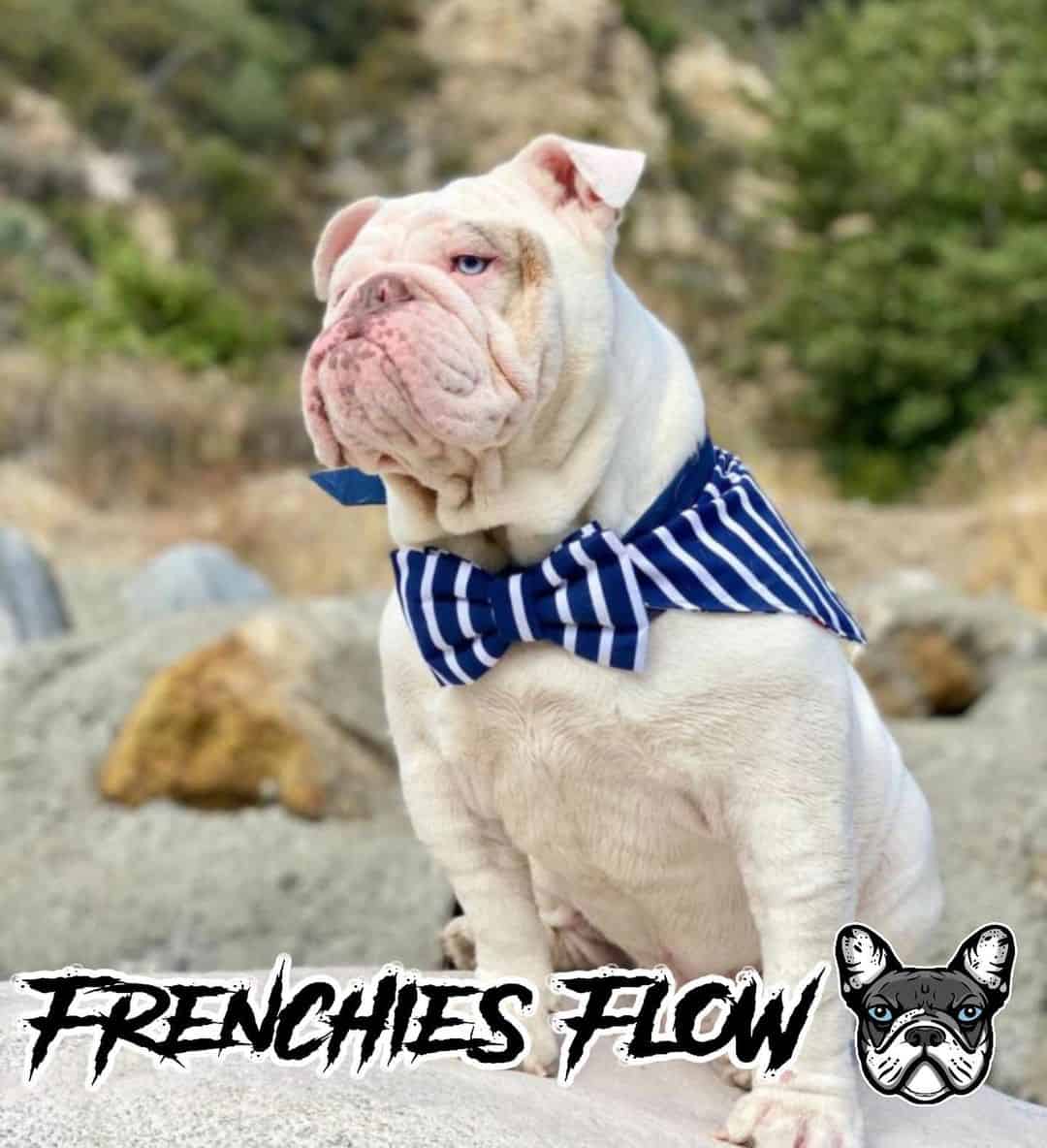
Photo from: @frenchiesflow
Albino English Bulldogs don’t come in a specific color. Instead, they have a genetic condition that disables the pigment distribution, meaning they lack color.
Dogs with albinism come in pure white, and their eyes are either blue or have a red tint. Their noses, lips, eyeliners, and paw pads are pink because there is no part of their body with pigment.
Just like merles, dogs with albinism also tend to suffer from a plethora of health conditions. They have problems with their sight, hearing, skin, even their heart, and bones.
Albinism spreads through a recessive gene, meaning that both parents need to have this gene for the puppy to have albinism. However, this also means that neither of the parents has to suffer from albinism to carry it. They might be passive carriers that will spread the condition to their offspring.
Albino dogs are also frowned upon by most responsible breeders. However, the popularity of albino animals has increased the demand for these dogs, which is why many English Bulldogs with albinism are priced highly.
Unique Patterns
While there are many English Bulldog colors, there are just as many various patterns they can come in. This includes:
• Piebald
• Tri-color
• Sable
• Black mask
• White markings
• Ticked
Any of the colors we’ve mentioned (except albino and merle) can come in any of these patterns. Also, all but tri-color are accepted by the AKC.
Piebald English Bulldog Colors
Piebald dogs, also known as pied, are dogs with large, irregular spots on a base coat. Yes, this isn’t a true coat color but rather a color pattern.
Pied dogs can come in various different colors, but most of the time, they are in two shades. One coat color – usually the base – will be white, while the other is darker, and it can be brindle, red, fallow, black, blue, or any other standard and non-standard English Bulldog Color.
Sable English Bulldog Colors
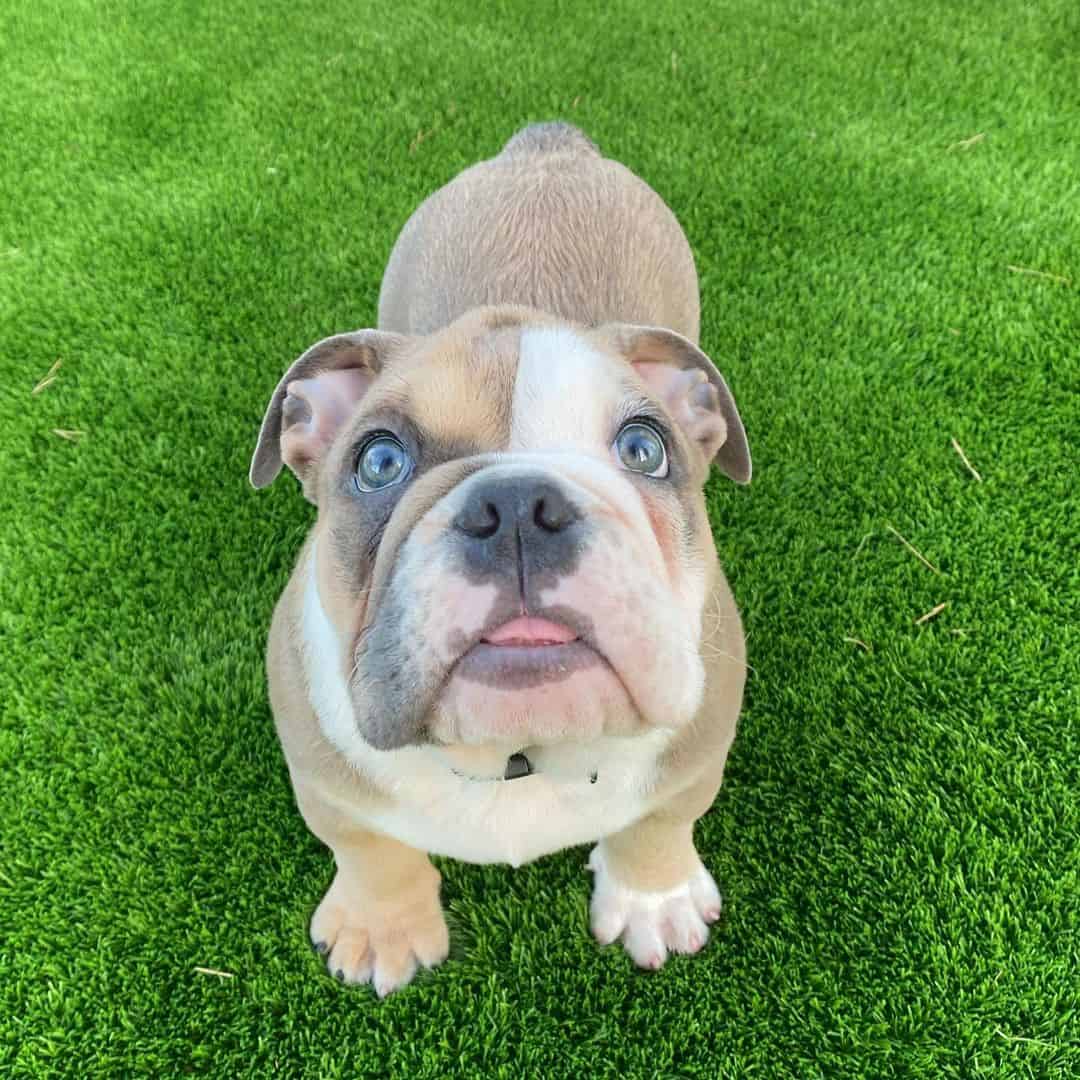
Photo from: @augustus_gloop_mcr
Sable dogs have hair of any base color but with black tips on each individual hair strand. This can make them appear much darker than the base color truly is.
In most areas, sable English Bulldogs won’t be described as sable, but they’ll simply address the marking by calling it black tips. However, there isn’t a real difference between a true sable and simply having black hair tips.
Sable can come on any base coat color except white and black. However, it will be the most noticeable on lighter coat colors, such as fallow or red.
Also, in some dogs, only a portion of the coat will be sable. This is usually the case with tri-color dogs.
Tri-Color English Bulldogs
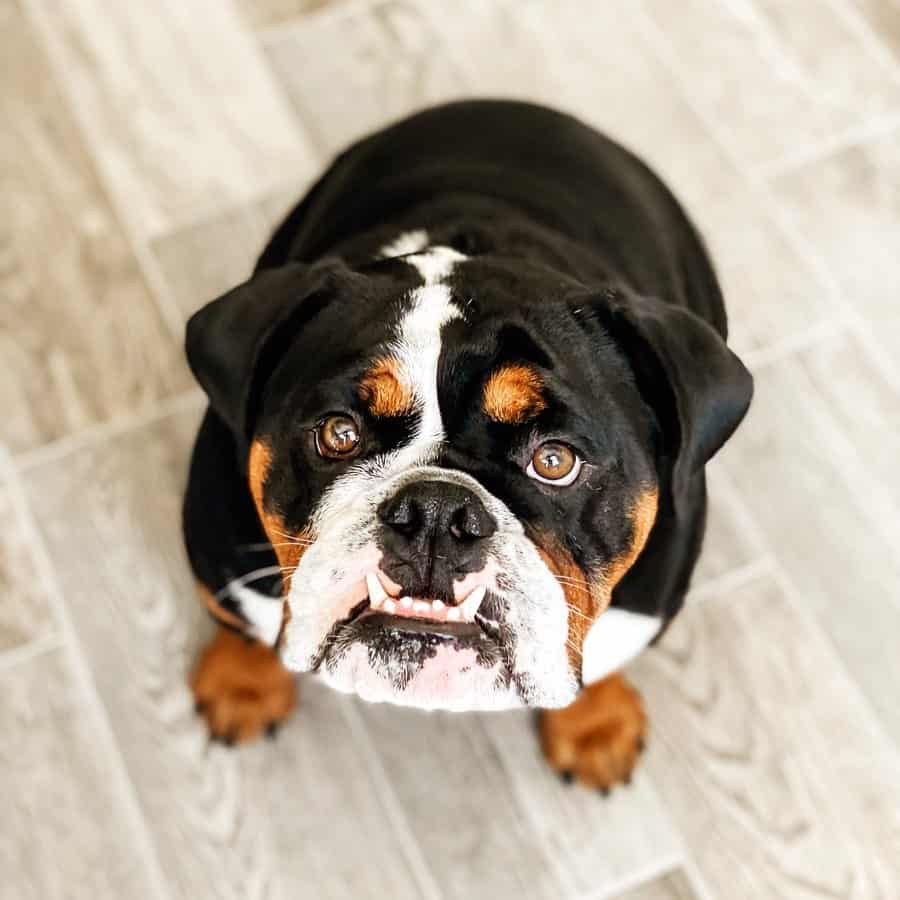
Photo from: @kratostheenglishbulldog
Despite being fairly common, tri-color English Bulldogs aren’t recognized by the AKC.
These dogs have coats in any of the three colors we’ve mentioned before. The combinations are almost endless, especially considering that these three colors can be spread out in any possible pattern.
In fact, you may even have an English Bulldog with a double pattern! You may have a tri-color dog with a trindle, for example.
Because of the belief that tri-color English Bulldogs are so rare, they tend to be quite expensive. The truth is, however, that there are much more tri-color Bulldogs than you might think, and the price is mostly because of the reputation.
Black Mask
While common in many other breeds, the black mask is somewhat rare in English Bulldogs.
Dogs with a black mask have a black color on their muzzles. This color can sometimes be spread on their cheeks and forehead, but this is quite rare.
Most of the time, fawn or black English Bulldogs are the ones with a black mask. Opposite of that, lilac, blue, and chocolate English Bulldogs cannot have a black mask, as the dilution gene would turn it into some other color.
White Markings
White markings are the most common pattern in English Bulldogs. Any white spots on a dog’s coat can be considered white markings.
Most of these white areas will occur on a dog’s stomach, paws, face, and chest, but they can be located anywhere.
For a dog to have white markings, he should come in a certain base color with a white coat in certain body areas. If the biggest part of an English Bulldog’s coat is white, this means that the dog has a white base coat with markings of some other color.
Ticked
Ticked dogs are simply – spotted dogs.
While you cannot find English Bulldogs that are as spotted as, for example, Dalmatians, colored specks are common on platinum dogs. In fact, some of these specks can help you know what the true base color of your dog is.
To be clearer – if your pup has a white coat with some liver-colored specks and a brown nose, he will be registered as a chocolate Bulldog instead of a white one.
English Bulldog Rare Colors
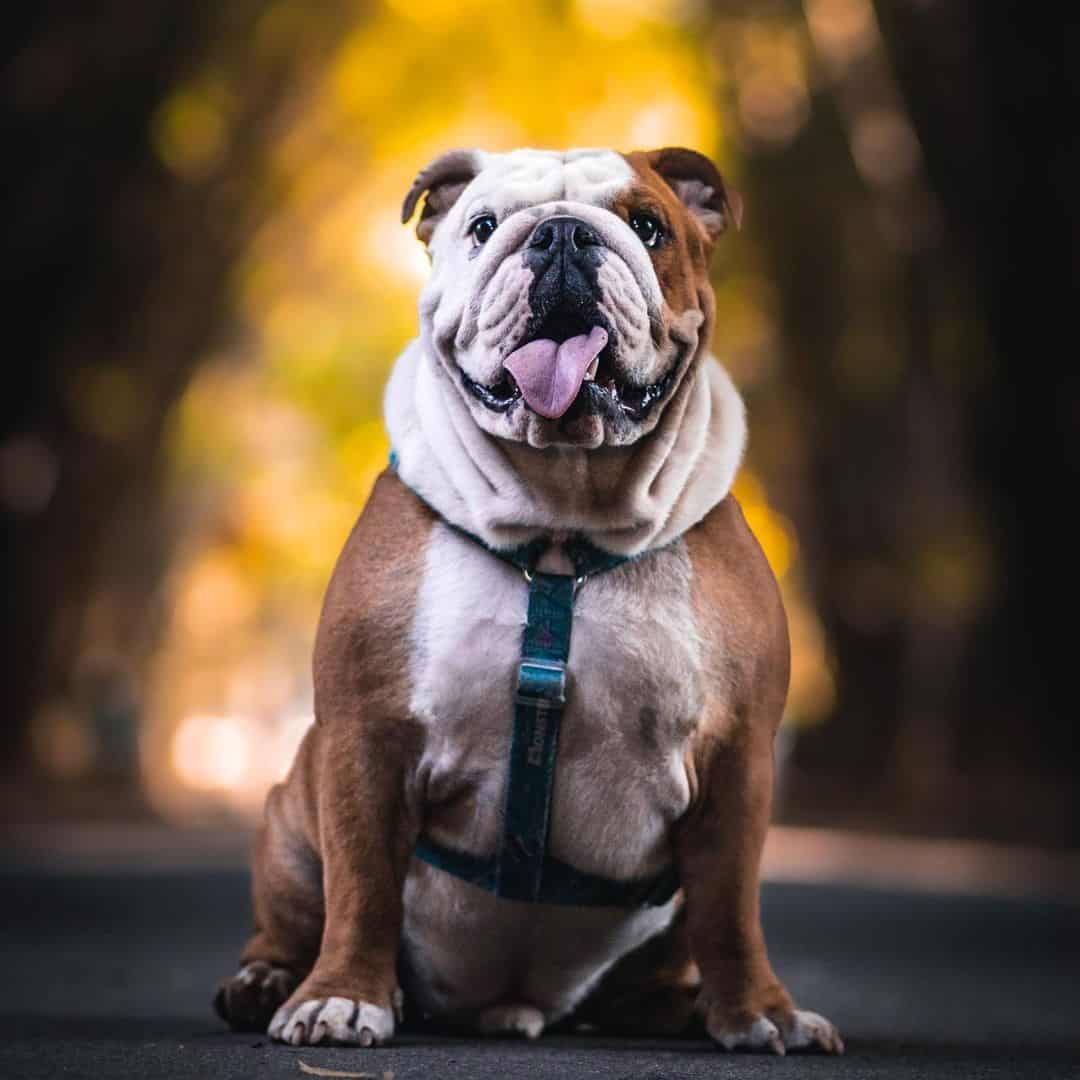
Photo from: @marcao_thebulldog
As you can see, there are plenty of English Bulldog colors available. However, not all are common – in fact, some are not allowed by kennel clubs. Still, this doesn’t necessarily make them rare.
For example, trindle English Bulldogs aren’t approved by the AKC, but they are still fairly common for this breed. This is because brindle is a common color in Bulldogs.
On the other hand, black – a seemingly rather ordinary color – is a true rarity within the breed! This means that any of its dilutes are also rare.
Because of this, four rare English Bulldog colors are:
• Black
• Chocolate
• Blue
• Lilac
All of these colors can be quite pricey, and finding an English Bulldog puppy in these shades is tricky.
What Is The Rarest Color For English Bulldogs?
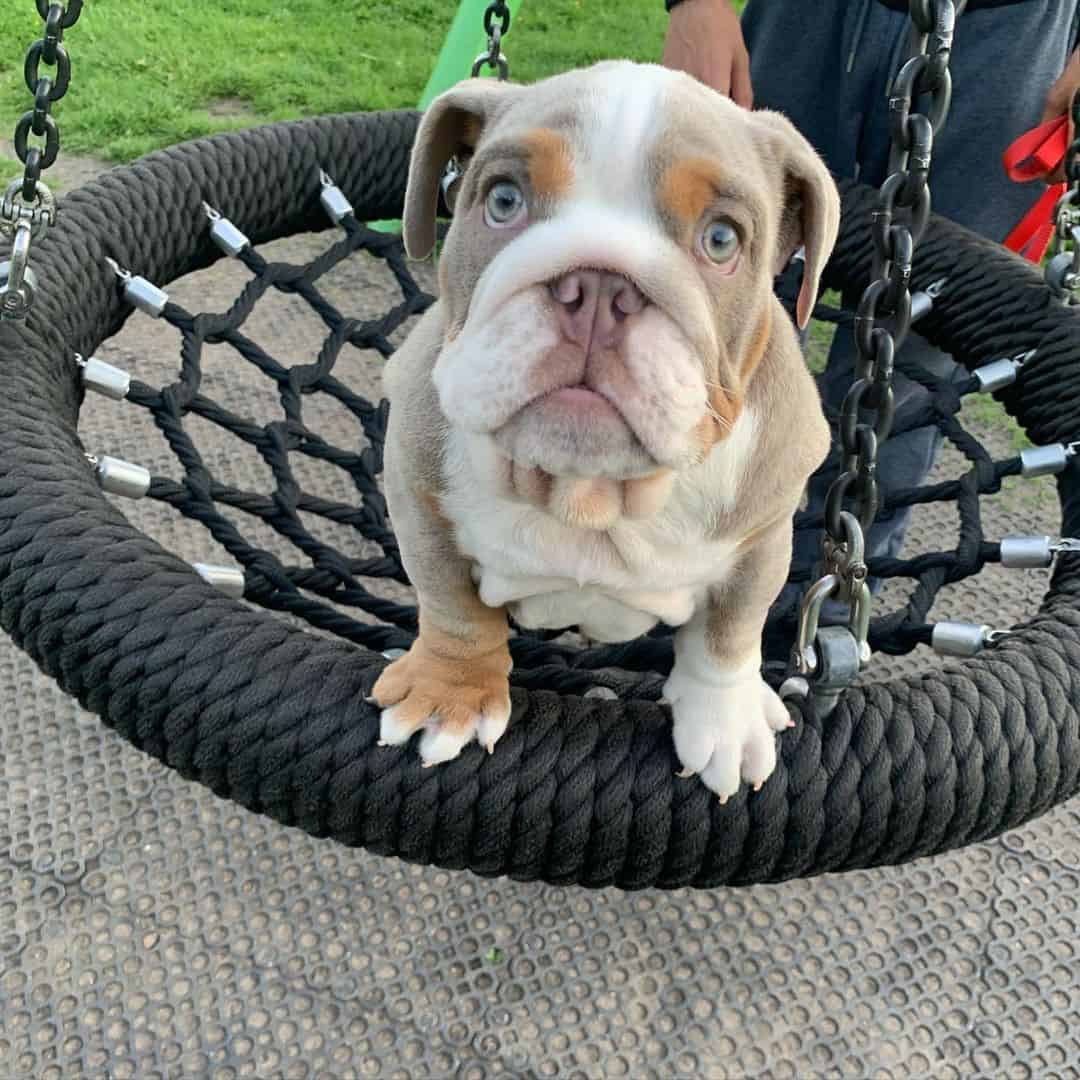
Photo from: @lilac_english_bulldog
While all of the English Bulldog colors mentioned are rare, not all are equally so. In fact, black Bulldogs can seem to be quite common in certain areas of the world.
The rarest of all English Bulldog colors is lilac. This is because lilac is the result of a very specific set of genes, and everything has to align in a certain way for a pup to end up with a double dilution.
All lilac English Bulldogs are very expensive. Breeding these dogs isn’t easy, and not many breeders can successfully produce several litters of dogs in this unique color.
Can English Bulldog Puppies Change Color?
Yes, English Bulldog puppies can change colors as they grow older. While this doesn’t happen all the time, it’s pretty common.
For example, most puppies in some diluted color will be born in a much darker shade than they’ll be when they grow up. Some of them might even be born black before settling into the color they are meant to be.
Brindle and sable are two colors especially prone to changing. Brindle dogs tend to be born black before their base coat becomes visible. At the same time, black tips in sable dogs can become lighter over time, sometimes turning grey.
Still, a reputable breeder with experience will be able to let you know what color your future English Bulldog puppy will most likely be, so this shouldn’t worry you too much. If you want to know what dog breed is known for changing its colors throughout its lifespan – you can find it out here.
Does Color Matter?
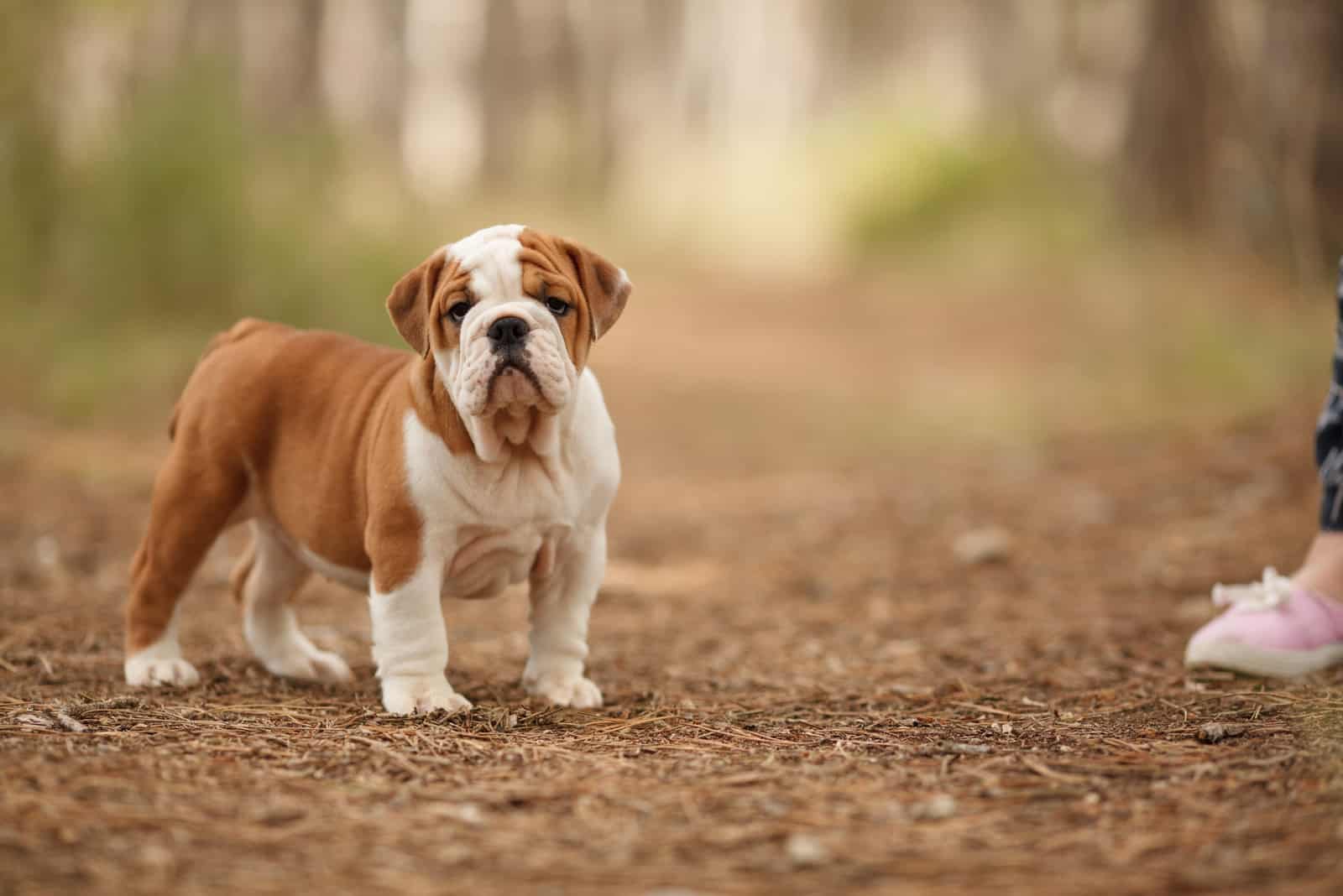
A common question many aspiring dog owners wonder is: “Does coat color really matter?” The answer is both yes and no.
Despite some rumors, there isn’t any proof that coat color affects behavior in any way. There are many other factors that contribute to a dog’s temperament, such as upbringing, socialization, and proper training. Coat color isn’t one of them.
However, some colors are connected to certain health problems, as we’ve already mentioned. All diluted colors have an increased chance of experiencing vision or hearing loss. The chocolate coat color is especially problematic, as there is some indication that dogs in this shade are overall more prone to health problems.
Certain colors, such as albino, white, and merle, have an extremely negative connotation, and most people refuse to breed these dogs. Unfortunately, this also means that those who decide to breed them can sell them at a very high price.
All in all, you shouldn’t allow the coat color of the dog to force you to make a final decision. Many other traits determine a good dog, such as temperament and dog breed.
English Bulldogs make amazing pets no matter the color of their fur. Still, it’s always nice to know all the English Bulldog colors and other trivia regarding the coat color, type, and grooming needs of these dogs.
Read Next: 25 Havanese Colors That Will Blow Your Mind
